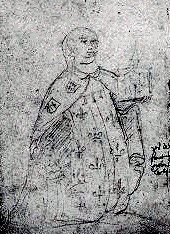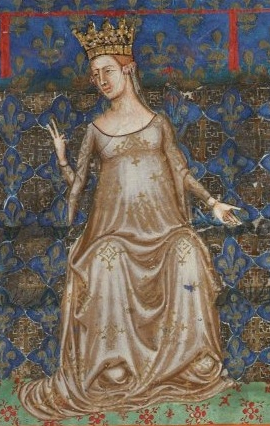Related Research Articles

Pope Clement IV, born Gui Foucois and also known as Guy le Gros, was bishop of Le Puy (1257–1260), archbishop of Narbonne (1259–1261), cardinal of Sabina (1261–1265), and head of the Catholic Church from 5 February 1265 until his death. His election as pope occurred at a conclave held at Perugia that lasted four months while cardinals argued over whether to call in Charles I of Anjou, the youngest brother of Louis IX of France, to carry on the papal war against the Hohenstaufens. Pope Clement was a patron of Thomas Aquinas and of Roger Bacon, encouraging Bacon in the writing of his Opus Majus, which included important treatises on optics and the scientific method.

Charles I, commonly called Charles of Anjou or Charles d'Anjou, was a member of the royal Capetian dynasty and the founder of the second House of Anjou. He was Count of Provence (1246–1285) and Forcalquier in the Holy Roman Empire, Count of Anjou and Maine (1246–1285) in France; he was also King of Sicily (1266–1285) and Prince of Achaea (1278–1285). In 1272, he was proclaimed King of Albania, and in 1277 he purchased a claim to the Kingdom of Jerusalem.

Peter III of Aragon was King of Aragon, King of Valencia, and Count of Barcelona from 1276 to his death. At the invitation of some rebels, he conquered the Kingdom of Sicily and became King of Sicily in 1282, pressing the claim of his wife, Constance II of Sicily, uniting the kingdom to the crown.

Frederick II was the regent of the Kingdom of Sicily from 1291 until 1295 and subsequently King of Sicily from 1295 until his death. He was the third son of Peter III of Aragon and served in the War of the Sicilian Vespers on behalf of his father and brothers, Alfonso ΙΙΙ and James ΙΙ. He was confirmed as king by the Peace of Caltabellotta in 1302. His reign saw important constitutional reforms: the Constitutiones regales, Capitula alia, and Ordinationes generales.

Charles II, also known as Charles the Lame, was King of Naples, Count of Provence and Forcalquier (1285–1309), Prince of Achaea (1285–1289), and Count of Anjou and Maine (1285–1290); he also styled himself King of Albania and claimed the Kingdom of Jerusalem from 1285. He was the son of Charles I of Anjou—one of the most powerful European monarchs in the second half of the 13th century—and Beatrice of Provence. His father granted Charles the Principality of Salerno in the Kingdom of Sicily in 1272 and made him regent in Provence and Forcalquier in 1279.

Manfred was the last King of Sicily from the Hohenstaufen dynasty, reigning from 1258 until his death. The natural son of the Holy Roman Emperor Frederick II, Manfred became regent over the kingdom of Sicily on behalf of his nephew Conradin in 1254. As regent he subdued rebellions in the kingdom, until in 1258 he usurped Conradin's rule. After an initial attempt to appease Pope Innocent IV he took up the ongoing conflict between the Hohenstaufens and the papacy through combat and political alliances. He defeated the papal army at Foggia on 2 December 1254. Excommunicated by three successive popes, Manfred was the target of a Crusade (1255–66) called first by Pope Alexander IV and then by Urban IV. Nothing came of Alexander's call, but Urban enlisted the aid of Charles of Anjou in overthrowing Manfred. Manfred was killed during his defeat by Charles at the Battle of Benevento, and Charles assumed kingship of Sicily.

Robert of Anjou, known as Robert the Wise, was King of Naples, titular King of Jerusalem and Count of Provence and Forcalquier from 1309 to 1343, the central figure of Italian politics of his time. He was the third son of King Charles II of Naples and Mary of Hungary, and during his father's lifetime he was styled Duke of Calabria (1296–1309).

The Kingdom of Sicily was a state that existed in the south of the Italian Peninsula and for a time the region of Ifriqiya from its founding by Roger II of Sicily in 1130 until 1816. It was a successor state of the County of Sicily, which had been founded in 1071 during the Norman conquest of the southern peninsula. The island was divided into three regions: Val di Mazara, Val Demone and Val di Noto.

Louis II was Duke of Anjou and Count of Provence from 1384 to 1417; he claimed the Kingdom of Naples, but only ruled parts of the kingdom from 1390 to 1399. His father, Louis I of Anjou—the founder of the House of Valois-Anjou—was a younger son of King John II of France and the adopted son of Queen Joanna I of Naples. When his father died during a military campaign in Naples in 1384, Louis II was still a child. He inherited Anjou from his father, but his mother, Marie of Blois, could not convince his uncles, John, Duke of Berry and Philip II, Duke of Burgundy, to continue her husband's war for Naples. The Provençal nobles and towns refused to acknowledge Louis II as their lawful ruler, but Marie of Blois persuaded them one after another to swear fealty to him between 1385 and 1387.

The Kingdom of Albania was established by Charles of Anjou in the Albanian territories he conquered from the Byzantine Empire in 1271, with the help of the local Albanian nobility. The Kingdom of Albania was declared in late February 1272. The kingdom extended from the region of Durazzo south along the coast to Butrint. A major attempt to advance further in direction of Constantinople failed at the Siege of Berat (1280–1281). A Byzantine counteroffensive soon ensued, which drove the Angevins out of the interior by 1281. The Sicilian Vespers further weakened the position of Charles, and the Kingdom was soon reduced by the Byzantines to a small area around Durazzo. The Angevins held out here, however, until 1368, when the city was captured by Karl Thopia. In 1392, Karl Thopia's son surrendered the city to the Republic of Venice.

Robert II was the Count of Artois, the posthumous son and heir of Robert I and Matilda of Brabant. He was a nephew of Louis IX of France. He died at the Battle of the Golden Spurs.

Mahaut of Artois also known as Mathilda, ruled as Countess of Artois from 1302 to 1329. She was furthermore regent of the County of Burgundy from 1303 to 1315 during the minority and the absence of her daughter, Joan II, Countess of Burgundy.

Mary of Hungary, of the Árpád dynasty, was Queen of Naples by marriage to King Charles II. She was a daughter of Stephen V of Hungary and his wife Elizabeth the Cuman. Mary served as regent in Provence in 1290–1294 and in Naples in 1295–96, 1296–98, and 1302, during the absences of her husband.

The War of the Sicilian Vespers, also shortened to the War of the Vespers, was a conflict waged by several medieval European kingdoms over control of Sicily from 1282 to 1302. The war, which started with the revolt of the Sicilian Vespers, was fought over competing dynastic claims to the throne of Sicily and grew to involve the Kingdom of Aragon, Angevin Kingdom of Naples, Kingdom of France, and the papacy.

Beatrice of Provence, was ruling Countess of Provence and Forcalquier from 1245 until her death, as well as Countess of Anjou and Maine, Queen of Sicily and Naples by marriage to Charles I of Naples.

Eleanor of Anjou was Queen of Sicily as the wife of King Frederick II of Sicily. She was a member of the Capetian House of Anjou by birth.

The Capetian House of Anjou, or House of Anjou-Sicily, was a royal house and cadet branch of the direct French House of Capet, part of the Capetian dynasty. It is one of three separate royal houses referred to as Angevin, meaning "from Anjou" in France. Founded by Charles I of Anjou, the youngest son of Louis VIII of France, the Capetian king first ruled the Kingdom of Sicily during the 13th century. The War of the Sicilian Vespers later forced him out of the island of Sicily, which left him with the southern half of the Italian Peninsula, the Kingdom of Naples. The house and its various branches would go on to influence much of the history of Southern and Central Europe during the Middle Ages until it became extinct in 1435.

The Diocese of Mileto-Nicotera-Tropea is a Roman Catholic ecclesiastical territory in Calabria, southern Italy, created in 1986. In that year the historical Diocese of Mileto was united with the Diocese of Nicotera-Tropea. The diocese is a suffragan of the Archdiocese of Reggio Calabria-Bova.
Philip, of the Capetian House of Anjou, was the second son of King Charles I of Sicily and Countess Beatrice of Provence. He was at various times set up to become King of Sardinia, Prince of Achaea or King of Thessalonica, but ultimately ascended no throne.
Blanche of Sicily, also called Blanche of Anjou, was the eldest surviving child born to Charles of Anjou and his first wife, Beatrice, the reigning Countess of Provence and Forcalquier. She later married Robert, the future Count of Flanders.
References
Citations
- ↑ Dunbabin 2001, p. 115.
- 1 2 3 4 5 6 7 Backman 2002, p. 594.
- ↑ Lower 2018, pp. 144–145.
- 1 2 3 4 5 6 7 Lamboglia 2010, p. 1061.
- 1 2 3 4 Pio 2006.
- ↑ Gregorovius 2010, p. 624.
- ↑ Symes 2007, p. 263.
- ↑ Stanton 2019, p. 5.
- ↑ Abulafia 2000, p. 100.
- ↑ Clarke 2005, p. 140.
- ↑ Clarke 2005, p. 141.
- 1 2 Backman 2002, p. 595.
- ↑ Lledó-Guillem 2018, p. 31.
- ↑ Lower 2018, p. 145.
- ↑ Laureys 2006, p. 40.
Bibliography
- Abulafia, David (2000). "Charles of Anjou reassessed". Journal of Medieval History . 26 (1): 93–114. doi:10.1016/S0304-4181(99)00012-3. S2CID 159990935.
- Backman, Clifford R. (2002). "Review: Die Chronik des Saba Malaspina". Speculum . 77 (2): 593–595. doi:10.2307/3301403. JSTOR 3301403.
- Clarke, Peter D. (2005). "Review: Die Chronik des Saba Malaspina". The Journal of Ecclesiastical History . 56 (1): 140–141. doi:10.1017/S0022046904472182. S2CID 162304832.
- Dunbabin, Jean (2001). "Charles I of Anjou and the Development of Medieval Political Ideas". Nottingham Medieval Studies. 45: 110–126. doi:10.1484/J.NMS.3.323.
- Gregorovius, Ferdinand (2010). History of the City of Rome in the Middle Ages. Cambridge University Press. ISBN 9781108015066.
- Lamboglia, Rosanna (2010). "Malaspina, Saba". In Graeme Dunphy; Cristian Bratu (eds.). Encyclopedia of the Medieval Chronicle . ISBN 9789004184640.
- Laureys, Marc (2006). "Antiquarianism and Politics in 14th-century Avignon: The Humanism of Giovanni Cavallini". In Jan Papy; Karl A. E.. Enenkel (eds.). Petrarch and His Readers in the Renaissance. Brill. ISBN 9789047408505.
- Lledó-Guillem, Vicente (2018). The Making of Catalan Linguistic Identity in Medieval and Early Modern Times. Springer International Publishing. ISBN 9783319720807.
- Lower, Michael (2018). The Tunis Crusade of 1270: A Mediterranean History. Oxford University Press. ISBN 9780198744320.
- Pio, Berardo (2006). "Malaspina, Saba". Dizionario Biografico degli Italiani, Volume 67: Macchi–Malaspina (in Italian). Rome: Istituto dell'Enciclopedia Italiana. ISBN 978-8-81200032-6.
- Stanton, Charles D. (2019). Roger of Lauria (c.1250-1305): "Admiral of Admirals". Boydell Press. ISBN 9781787445901.
- Symes, Carol (2007). A Common Stage: Theater and Public Life in Medieval Arras. Cornell University Press. ISBN 9781501726613.